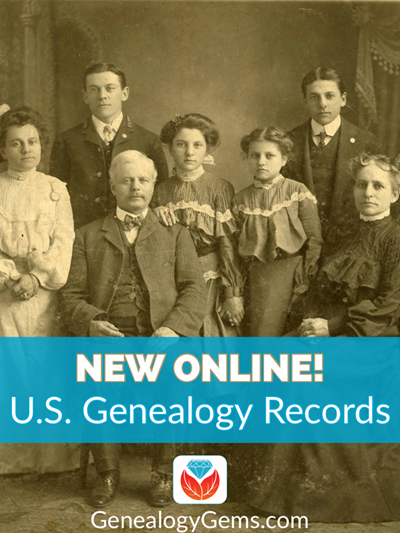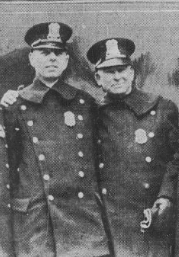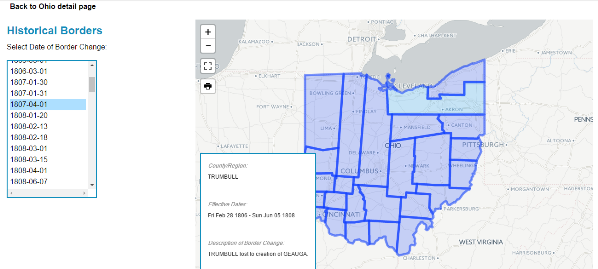by Lisa Cooke | Sep 25, 2015 | 01 What's New, Ancestry, British, Census, FamilySearch, Findmypast, images, Irish, Italian, Records & databases, School Records, United States
Every week we blog about new genealogy records online. Which ones might help you find your family history? New this week: more Italian civil registrations, Ohio and Pennsylvania marriage records, thousands of New York genealogical resources, Illinois state censuses and school records for England, Wales, Ireland and Australia.

SCHOOL RECORDS. Nearly 2.9 million School Admission Register records from England and Wales, Ireland and NSW, Australia are now searchable on Findmypast. Record content varies, but according to Findmypast, “These fascinating new records can allow you a glimpse into your ancestors’ early life, pinpoint the area they grew up in, reveal if they had a perfect attendance or occasionally played truant and can even determine whether they worked in a school as an adult.”
ILLINOIS STATE CENSUSES. Ancestry has updated its collection of Illinois state censuses, which now include 1825, 1835, 1845, 1855 and 1865, along with 1865 agricultural schedules for several counties and nonpopulation schedules of the federal censuses for 1850-1880. (Learn more about U.S. state censuses here.)
ITALY CIVIL REGISTRATIONS. FamilySearch continues to upload Italy’s civil registration records. This week, they added browse-only records (not yet indexed) for Potenza, Rieti and Trapani.
NEW YORK GENEALOGY MATERIAL. Thousands of pages of materials from the New York Genealogical and Biographical Society are now searchable on Findmypast. Among these are all back issues of the NYG&B Record, the second-oldest genealogical journal in the U.S. (in print since 1870). Findmypast’s Joshua Taylor calls it “the single most important scholarly resource that exists for people researching New York families.” Other collections include unique census fragments, vital records abstracts, baptismal registers and old diaries. Click here to see and search the full list.
OHIO MARRIAGES. More than a quarter million indexed records and thousands of images have been added to FamilySearch’s collection of Ohio marriage records for 1789-2013.
PENNSYLVANIA MARRIAGES. Over a million digitized images of Pennsylvania civil marriage records (1677-1950) are now free to browse at FamilySearch. The collection description says it’s an “index and images of various city and county marriage records, many from Philadelphia.”
 Did you find anything worth sharing here? Please do! We love getting the word out about new genealogy records online.
Did you find anything worth sharing here? Please do! We love getting the word out about new genealogy records online.
by Lisa Cooke | Sep 17, 2019 | 01 What's New, Records & databases
If there’s one thing we want to see coming online every single day, it’s new digitized genealogy records! A genealogical brick wall that has been sitting dormant for years can be broken down if just the right records becomes available. And we never know when that will happen.
This week I’m sharing some of the genealogy records that have come online in the last few weeks. These records comes from across the United States. They include wills and probate, police and mug shots, and cemetery records. Perhaps your ancestor’s record is among them.

Wills and Probate Records
Do you have ancestors’ from Maryland? Search this collection of Wills and Probates at Findmypast to find out the date of their Will.
As confirmed in the introduction of the publication, the Maryland Calendar of Wills was compiled in response to an already “long existent and steadily increasing need for such work, a need not only of genealogists, nor only for Marylanders now living in the State, but also for the large class of persons, whose ancestors are to be numbered among the men and women who took part in the nation-building as begun on Maryland shores, and whose descendants are now to be found in every State of the Union.”
Each record is available in a PDF format. Use the previous and next buttons at the top of the page to browse through the publication.
The General Index of Wills of St. Mary’s County, Maryland, 1633 to 1900 was compiled by Margaret Roberts Hodges from original indices, the collection of records were published by the Carter Braxton Chapter of the Daughters of the American Revolution.
You can also Search this index to more than 107,000 probate records from Maryland between 1634 to 1777 for transcripts and images of both Prerogative Court and County records. The amount of information listed in each record will vary but looking at images is always recommended.
Preceding the implementation of the first Maryland State Constitution in 1777, two sets of probate records were maintained, probate business was conducted at the capital by the central agency which, for most of the Colonial period, was known as the Prerogative Court.
The Commissary General was the presiding officer of the court and a Deputy Commissary was then appointed for each county. The Deputy Commissary recorded each probate record that was brought into their office, periodically they would send the papers filed in their office to the Prerogative Court where they would be recorded again.
Mugs Shots and More Going Back 150 Years
Records from the Indianapolis Fire Department and the Indianapolis Metropolitan Police Department have been digitized and are available online.
Thanks to a $1.8 million grant from the Lilly Endowment, The Central Library in Indianapolis recently unveiled the collection, which includes some items dating back 150-years.

The items have been added to an existing collection of from the Indianapolis Firefighters Museum and include:
- log books,
- dispatch recordings,
- personnel records,
- newsletters,
- historical photos and
- prisoner mug shots
IMPD Deputy Chief Michael Spears said “The City of Indianapolis has a police department of which it can be extremely proud. This collection is the most complete and definitive collection of documents, photographs, videos and other exhibits ever compiled.”
“The Indianapolis Fire Department has a rich and proud 160-year history, and through our partnership with the Indianapolis Public Library, we are preserving that history for future generations,” said Tom Hanify, Professional Firefighters Union of Indiana President.
You can search this unique collection for free at http://www.digitalindy.org/ If you have family history rooted in the Indianapolis area, you’re in for a treat because the website include a wide range of historical content!
118,000+ New Cemetery Records Added
From Internment.com: Interment.net added 118,768 new cemetery records since our last report (January 2018), covering 49 cemeteries across 14 states.
Interment.net is one the oldest and largest archives of cemetery transcriptions, since 1997, and is still committed to serving genealogists at no cost.
Contained on our website are tens of millions of records, covering tens of thousands of cemeteries, from across the world.
Our records are obtained from databases direct from cemeteries, churches, libraries, and government offices, as well as from complete works of tombstone transcriptions.

Here’s the list of cemetery records published recently:
Quebec, Canada
Brome County, Saint-Cajetan Cemetery, Mansonville, 722 records
Arthabaska County, Lorne Cemetery, Kingsley Station, 63 records
Arthabaska County, Trout Brook Cemetery, Tingwick, 127 records
Temiscouata, Cabano Cemetery, Temiscouata-sur-le-Lac, 2,117 records
Ontario, Canada
Bruce County, Culross and Teeswater Cemetery, Teeswater, 2,268 records
Ireland
County Wexford, Ballyhuskard Graveyard, Ballynastraw, 120 records
Alaska
Ketchikan Gateway Borough, Bayview Cemetery, Ketchikan, 5,291 records
Arizona
Apache County, St. Johns Cemetery, St. Johns, 1,400 records
California
Monterey County, Holy Trinity Cemetery, Greenfield, 500+ records
Monterey County, Oak Park Cemetery, Greenfield, 500+ records
Napa County, Pioneer Cemetery, Calistoga, 950 records
Los Angeles County, Fairmount Cemetery, Azusa, 250 records
Michigan
Genesee County, Garden of Peace Cemetery, Swartz Creek, 56 records
Genesee County, Swartz Creek Cemetery, Swartz Creek, 261 records
Clinton County, Rose Cemetery, Bath Township, 1,442 records
Clinton County, Pleasant Hill Cemetery, Bath Township, 1,806 records
Minnesota
Carver County, Chanhassen Pioneer Cemetery, Chanhassen, 850 records
McLeod County, Oakland Cemetery, Hutchinson, 8,755 records
Anoka County, East Bethel Cemetery, East Bethel, 100 records
Anoka County, Old East Bethel Cemetery, East Bethel, 178 records
Anoka County, Oak Leaf Cemetery, East Bethel, 650 records
Missouri
New Madrid County, Evergreen Cemetery, New Madrid, 2,500 records (approx)
New Madrid County, Davis Cemetery, Kewanee, 14 records
New Madrid County, East Side Cemetery, New Madrid, 128 records
New Madrid County, Cedar Grove Cemetery, New Madrid Township, 25 records
New Madrid County, A.C. LaForge Cemetery, New Madrid Township, 4 records
New Madrid County, Augustine Cemetery, New Madrid, 2 records
New Madrid County, Byrne-Howard Cemetery, New Madrid, 32 records
St. Louis County, Eberwein Family Cemetery, Chesterfield, 9 records
St. Louis County, Harugari Cemetery, Manchester, 21 records
St. Louis County, St. Mary’s Cemetery, Hazelwood, 1,071 records
St. Louis County, St. Monica Cemetery, Creve Coeur, 801 records
St. Louis County, St. Peter Cemetery, Kirkwood, 3,589 records
St. Louis County, St. Ferdinand Cemetery, Hazelwood, 3,426 records
St. Charles County, Ste. Philippine Cimetiere, St. Charles, 369 records
Jefferson County, St. Vincent Cemetery, Fenton, 33 records
Nebraska
Scotts Bluff County, East Lawn Cemetery, Mintare, 1,900 records
New York
Allegany County, Mount Pleasant Cemetery, Houghton, 724 records
Allegany County, Caneadea Cemetery, Caneadea, 430 records
Allegany County, East Caneadea Cemetery, Caneadea, 102 records
North Carolina
Nash County, Rocky Mount Memorial Park, Rocky Mount, 4,192 records
Ohio
Montgomery County, Happy Corner Cemetery, Englewood, 600 records
Oklahoma
Comanche County, Ft. Sill National Cemetery, Elgin, 6,093 records
Pennsylvania
Elk County, Denison Family Cemetery, Jay Township, 3 records
South Carolina
Anderson County, M. J. “Dolly” Cooper Veterans Cemetery, Anderson, 2,811 records
Richland County, Fort Jackson National Cemetery, Columbia, 5,548 records
Tennessee
Lawrence County, Richardson Cemetery, Centerpoint, 55 records
Texas
Swisher County, Rose Hill Cemetery, Tulia, 6,107 records
Hays County, San Marcos City Cemetery, 6,391 records
Washington State
King County, St. Patrick’s Cemetery, Kent, 760 records
Cowlitz County, Longview Memorial Park, Longview, 17,335 records
Kittitas County, Cacciatori D’Africa Cemetery, Roslyn, 25 records
Klickitat County, Stonehenge WWI Memorial, Maryhill, 14 records
Wisconsin
Marinette County, Forest Home Cemetery, Marinette, 22,800 records
Marinette County, Calvary Cemetery, Marinette, 48 records
Marinette County, Woodlawn Cemetery, Marinette, 2,400 records
Search these records at Interment.net.
Military
The Department of Veterans Affairs and National Cemetery Administration has created a new platform that creates digital memorials for all veterans in national cemeteries.
According to the website, the Veterans Legacy Memorial is “an online memorial space for Veterans managed by the National Cemetery Administration (NCA) of the U.S. Department of Veterans Affairs (VA). NCA manages 136 national cemeteries as shrine spaces to honor our Nation’s Veterans and extends memorialization of the 3.7 million Veterans interred in NCA cemeteries to this digital memorial space, providing a VLM profile page for each.
To find the memorial profile of a Veteran, please enter the name of your Veteran in the format of First Last with no commas (“John Doe” not “Doe, John”). To search with additional information (branch of service, cemetery name, etc.), please click on Advanced Search.”
Visit and search the Veterans Legacy Memorial here.
More Genealogy Records Coming Next Week
We report on the newest genealogy records that have come online each week. Subscribe to the free Genealogy Gems newsletter here to get notification, and you’ll also received my free ebook on googling search strategies for genealogy.


 The
The 





